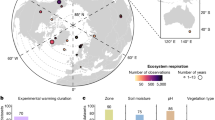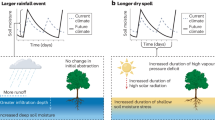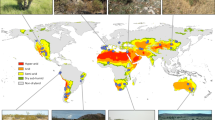Abstract
Most ecosystem models predict that climate warming will stimulate microbial decomposition of soil carbon, producing a positive feedback to rising global temperatures1,2. Although field experiments document an initial increase in the loss of CO2 from soils in response to warming, in line with these predictions, the carbon dioxide loss from soils tends to decline to control levels within a few years3,4,5. This attenuation response could result from changes in microbial physiological properties with increasing temperature, such as a decline in the fraction of assimilated carbon that is allocated to growth, termed carbon-use efficiency6. Here we explore these mechanisms using a microbial-enzyme model to simulate the responses of soil carbon to warming by 5 ∘C. We find that declines in microbial biomass and degradative enzymes can explain the observed attenuation of soil-carbon emissions in response to warming. Specifically, reduced carbon-use efficiency limits the biomass of microbial decomposers and mitigates the loss of soil carbon. However, microbial adaptation or a change in microbial communities could lead to an upward adjustment of the efficiency of carbon use, counteracting the decline in microbial biomass and accelerating soil-carbon loss. We conclude that the soil-carbon response to climate warming depends on the efficiency of soil microbes in using carbon.
This is a preview of subscription content, access via your institution
Access options
Subscribe to this journal
Receive 12 print issues and online access
$259.00 per year
only $21.58 per issue
Buy this article
- Purchase on Springer Link
- Instant access to full article PDF
Prices may be subject to local taxes which are calculated during checkout



Similar content being viewed by others
References
Friedlingstein, P. et al. Climate–carbon cycle feedback analysis: Results from the C4MIP model intercomparison. J. Clim. 19, 3337–3353 (2006).
Lloyd, J. & Taylor, J. A. On the temperature dependence of soil respiration. Funct. Ecol. 8, 315–323 (1994).
Luo, Y. Q., Wan, S. Q., Hui, D. F. & Wallace, L. L. Acclimatization of soil respiration to warming in a tall grass prairie. Nature 413, 622–625 (2001).
Melillo, J. M. et al. Soil warming and carbon-cycle feedbacks to the climate system. Science 298, 2173–2176 (2002).
Oechel, W. C. et al. Acclimation of ecosystem CO2 exchange in the Alaskan Arctic in response to decadal climate warming. Nature 406, 978–981 (2000).
Steinweg, J. M., Plante, A. F., Conant, R. T., Paul, E. A. & Tanaka, D. L. Patterns of substrate utilization during long-term incubations at different temperatures. Soil Biol. Biochem. 40, 2722–2728 (2008).
Eliasson, P. E. et al. The response of heterotrophic CO2 flux to soil warming. Glob. Change Biol. 11, 167–181 (2005).
Kirschbaum, M. U. F. Soil respiration under prolonged soil warming: Are rate reductions caused by acclimation or substrate loss? Glob. Change Biol. 10, 1870–1877 (2004).
Knorr, W., Prentice, I. C., House, J. I. & Holland, E. A. Long-term sensitivity of soil carbon turnover to warming. Nature 433, 298–301 (2005).
Schimel, J. P. & Weintraub, M. N. The implications of exoenzyme activity on microbial carbon and nitrogen limitation in soil: A theoretical model. Soil Biol. Biochem. 35, 549–563 (2003).
Fontaine, S. & Barot, S. Size and functional diversity of microbe populations control plant persistence and long-term soil carbon accumulation. Ecol. Lett. 8, 1075–1087 (2005).
Davidson, E. A. & Janssens, I. A. Temperature sensitivity of soil carbon decomposition and feedbacks to climate change. Nature 440, 165–173 (2006).
Bárcenas-Moreno, G., Gómez-Brandón, M., Rousk, J. & Bååth, E. Adaptation of soil microbial communities to temperature: Comparison of fungi and bacteria in a laboratory experiment. Glob. Change Biol. 15, 2950–2957 (2009).
Bradford, M. A. et al. Thermal adaptation of soil microbial respiration to elevated temperature. Ecol. Lett. 11, 1316–1327 (2008).
Saleska, S. R., Harte, J. N. & Torn, M. S. The effect of experimental ecosystem warming on CO2 fluxes in a montane meadow. Glob. Change Biol. 5, 125–141 (1999).
Waldrop, M. P., Balser, T. C. & Firestone, M. K. Linking microbial community composition to function in a tropical soil. Soil Biol. Biochem. 32, 1837–1846 (2000).
López-Urrutia, Á. & Morán, X. A. G. Resource limitation of bacterial production distorts the temperature dependence of oceanic carbon cycling. Ecology 88, 817–822 (2007).
Rinnan, R., Michelsen, A., Bååth, E. & Jonasson, S. Fifteen years of climate change manipulations alter soil microbial communities in a subarctic heath ecosystem. Glob. Change Biol. 13, 28–39 (2007).
Allison, S. D. & Treseder, K. K. Warming and drying suppress microbial activity and carbon cycling in boreal forest soils. Glob. Change Biol. 14, 2898–2909 (2008).
Schuur, E. A. G. et al. The effect of permafrost thaw on old carbon release and net carbon exchange from tundra. Nature 459, 556–559 (2009).
Jonasson, S., Castro, J. & Michelson, A. Litter, warming and plants affect respiration and allocation of soil microbial and plant C, N and P in arctic mesocosms. Soil Biol. Biochem. 36, 1129–1139 (2004).
Hochachka, P. W. & Somero, G. N. Biochemical Adaptation: Mechanism and Process in Physiological Evolution (Oxford Univ. Press, 2002).
Raich, J. W., Russell, A. E., Kitayama, K., Parton, W. J. & Vitousek, P. M. Temperature influences carbon accumulation in moist tropical forests. Ecology 87, 76–87 (2006).
Parton, W. J., Stewart, J. W. B. & Cole, C. V. Dynamics of C, N, P, and S in grassland soils—a model. Biogeochemistry 5, 109–131 (1988).
Mack, M. C., Schuur, E. A. G., Bret-Harte, M. S., Shaver, G. R. & Chapin, F. S. III. Ecosystem carbon storage in arctic tundra reduced by long-term nutrient fertilization. Nature 433, 440–443 (2004).
Liu, W., Zhang, Z. & Wan, S. Predominant role of water in regulating soil and microbial respiration and their responses to climate change in a semiarid grassland. Glob. Change Biol. 15, 184–195 (2009).
Bonan, G. Carbon cycle: Fertilizing change. Nature Geosci. 1, 645–646 (2008).
Bosatta, E. & Ågren, G. I. Soil organic matter quality interpreted thermodynamically. Soil Biol. Biochem. 31, 1889–1891 (1999).
Six, J., Frey, S. D., Thiet, R. K. & Batten, K. M. Bacterial and fungal contributions to carbon sequestration in agroecosystems. Soil Sci. Soc. Am. J. 70, 555–569 (2006).
Trasar-Cepeda, C., Gil-Sotres, F. & Leirós, M. C. Thermodynamic parameters of enzymes in grassland soils from Galicia, NW Spain. Soil Biol. Biochem. 39, 311–319 (2007).
Acknowledgements
R. Conant, W. Parton and G. Ågren commented on the manuscript. M.D.W. and M.A.B. were supported by the US Department of Energy’s Office of Science (BER), S.D.A. by NSF Advancing Theory in Biology, and M.D.W. by DOE’s Northeastern Regional Center of the National Institute for Climatic Change Research, the USDA CSREES and NSF Ecosystems. The work is also a product of the NSF-supported Research Coordination Network on Enzymes in the Environment.
Author information
Authors and Affiliations
Contributions
M.A.B. and M.D.W. conceived the project, and S.D.A. built the model. S.D.A. and M.A.B. conducted model runs. All authors contributed to writing the paper.
Corresponding author
Ethics declarations
Competing interests
The authors declare no competing financial interests.
Supplementary information
Supplementary Information
Supplementary Information (PDF 519 kb)
Rights and permissions
About this article
Cite this article
Allison, S., Wallenstein, M. & Bradford, M. Soil-carbon response to warming dependent on microbial physiology. Nature Geosci 3, 336–340 (2010). https://doi.org/10.1038/ngeo846
Received:
Accepted:
Published:
Issue Date:
DOI: https://doi.org/10.1038/ngeo846
This article is cited by
-
Innovative approaches in soil carbon sequestration modelling for better prediction with limited data
Scientific Reports (2024)
-
Model uncertainty obscures major driver of soil carbon
Nature (2024)
-
Microbially mediated mechanisms underlie soil carbon accrual by conservation agriculture under decade-long warming
Nature Communications (2024)
-
Global emergent responses of stream microbial metabolism to glacier shrinkage
Nature Geoscience (2024)
-
Elevational patterns of microbial carbon use efficiency in a subtropical mountain forest
Biology and Fertility of Soils (2024)



